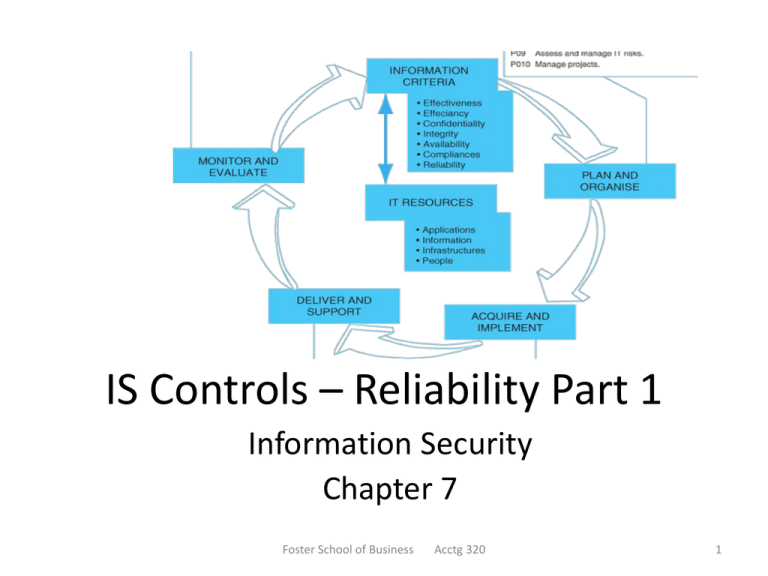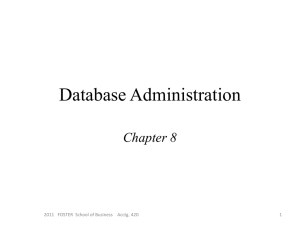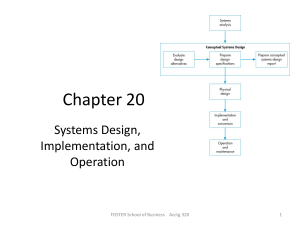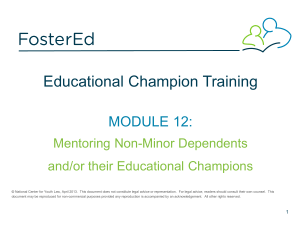IS Controls * Reliability Part 1
advertisement

IS Controls – Reliability Part 1 Information Security Chapter 7 Foster School of Business Acctg 320 1 Overview • Portions of chapter 7 are very technical, and beyond the scope of this course. • Read pages 251-253 quickly • Skim pages 264-270 become familiar with the terms. • Skip hashing on pg. 273. Foster School of Business Acctg 320 2 Overview--Questions • After reading the chapter, you should be able to answer the following: – How does security affect systems reliability? – What are the four criteria that can be used to evaluate the effectiveness of an organization’s information security? – What is the time-based model of security and the concept of defense-in-depth? – What types of preventive, detective, and corrective controls are used to provide information security? – How does encryption contribute to security and how do the two basic types of encryption systems work? Foster School of Business Acctg 320 3 Introduction • The five basic principles that contribute to systems reliability: AVAILABILITY PROCESSING INTEGRITY PRIVACY CONFIDENTIALITY SYSTEMS RELIABILITY – Security (focus of ch. 7) – Confidentiality (ch. 8) – Privacy (ch. 8) – Processing integrity (ch. 8) – Availability (ch. 8) SECURITY Foster School of Business Acctg 320 4 Basic Principles (1) SECURITY—controlled access, legit users. Foundation of systems reliability. (2) CONFIDENTIALITY—sensitive company information protected from unauthorized disclosure. (3) PRIVACY—personal information about customers collected, used, disclosed, and maintained in an appropriate manner. (4) PROCESSING INTEGRITY—data processed accurately, completely, and in a timely manner with proper authorization. (5) AVAILABILITY—system is available to meet operational and contractual obligations. Foster School of Business Acctg 320 5 Introduction • This chapter provides a broad introduction to the topic of information systems security. • Anyone interested in a career in information systems security would need to undertake additional detailed study. • Chapter 8 will discuss controls relevant to the other four reliability principles. Foster School of Business Acctg 320 6 Introduction • The press carries many stories about information security incidents including: – – – – Denial of service attacks Fraud Loss of trade secrets Identity theft • Accountants and IS professionals need to understand basic principles of information security in order to protect their organizations and themselves. Foster School of Business Acctg 320 7 COBIT and Trust Frameworks • COBIT Framework provides a comprehensive guidance for controlling and managing IS. • COBIT specifies detailed control objectives for 34 IT processes (fig. 7-2 in text). • We are interested in a subset of COBIT, SOX addresses the issue of system reliability. • The Trust Services Framework developed by the AICPA and CICA (Canadian) relates to systems reliability (security, confidentiality, privacy, process integrity, availability). Foster School of Business Acctg 320 8 Three FUNDAMENTAL INFORMATION SECURITY CONCEPTS (1) Security as a management issue, not a technology issue. (2) The time-based model of security. (3) Defense in depth. Foster School of Business Acctg 320 9 1) Security is a Management Issue, not a Technology Issue It is management’s job to report accurately and maintain an effective internal control structure (Sarbanes-Oxley) Most security problems are the result of poor management (ineffective defenses against threats, poor follow-up on controls, inadequate staffing, failure to prioritize, etc.) Foster School of Business Acctg 320 10 Four essential criteria for implementation of the 5 basic principals A) Developing and Documenting Policies: management has to develop a comprehensive set of security policies. B) Communicating to all authorized users: users must receive regular, periodic reminders about security policies and training in how to comply with them. C) Designing and employing appropriate controls: there are control frameworks that identify a series of procedures and tools that can be used to mitigate risk. D) Monitoring the system and taking corrective actions: follow through, attention to detail, independent checks. Foster School of Business Acctg 320 11 (2) The time-based model of security • Preventive controls not 100% effective. • Need to supplement preventive procedures with methods for detecting incidents and taking remedial action. • Detective controls: identify when protective controls have been breached • Pt = Time it takes to break through Preventive Controls • Dt = Time it takes to detect an attack is happening • Ct = Time it takes to Respond • If P > D+ C then security procedures are effective • Preventive controls should be strong enough so that it takes more time to break through controls than it takes to detect that an attack is under progress and rectify the situation. Foster School of Business Acctg 320 12 TIME-BASED MODEL OF SECURITY-example • For an additional expenditure of $25,000, the company could take one of four measures: – – – – Measure 1 would increase P by 5 minutes. Measure 2 would decrease D by 3 minutes. Measure 3 would decrease C by 5 minutes. Measure 4 would increase P by 3 minutes and reduce C by 3 minutes. • Because each measure has the same cost, which do you think would be the most cost-effective choice? (Hint: Your goal is to have P exceed [D + C] by the maximum possible amount.) Foster School of Business Acctg 320 13 TIME-BASED MODEL OF SECURITY— example solution • You may be able to solve this problem by eyeballing it. If not, one way to solve it is to assume some initial values for P, D, and C. • So let’s assume that P = 15 min., D = 5 min., and C = 8 min. • At our starting point, P – (D + C) = 15 – (5 + 8) = 2 min. • With Measure 1, P is increased by 5 minutes: – 20 – (5 + 8) = 7 min. • With Measure 2, D is decreased by 3 minutes: – 15 – (2 + 8) = 5 min. • With Measure 3, C is decreased by 5 min. – 15 – (5 + 3) = 7 min. • With Measure 4, P is increased by 3 minutes and C is reduced by 3 min. – 18 – (5 + 5) = 8 min. Foster School of Business Acctg 320 14 (3) Defense-in-depth • Multiple layers of controls in order to have protection against a single point of failure. • This is one area of IT in which redundancy is good. • Redundancy increases effectiveness because even if one procedure fails or is circumvented, another may function as planned. • The use of overlapping, complementary and redundant controls also buys time for organization to detect and react to attacks. • For example, banks use a combination of locked doors, bars on windows, security guards, and safes to provide multiple preventative controls to restrict physical access to cash. Foster School of Business Acctg 320 15 Typical Targeted Attacks • How are they done? – Reconnaissance – Social Engineering – Scan and Map – Research – Attack Execution – Cover Tracks Foster School of Business Acctg 320 16 PREVENTIVE CONTROLS • • • • • Authentication controls Authorization controls Training Physical Access Controls Remote Access Controls (User authentication, intrusion protection software) • Host and application hardening procedures (firewalls, antivirus) • Encryption We will look at each of these next. Foster School of Business Acctg 320 17 Authentication controls Authentication controls: Users can be authenticated by 1) Something they know (passwords or PINS) 2) Something they have (Smart cards or ID badges) 3) Physical characteristics (fingerprints, voice, retina) Multifactor authentication: stronger than one alone. Passwords: Length, Multiple character types (upper/lower case, numbers, letters), Randomness Change frequently, can be lost. With passwords you have to balance the improved security versus the cost of managing the complexity of security. Smart Card: like a credit card, but more sophisticated. It has a processor in it. Foster School of Business Acctg 320 18 Authorization • Authorization controls are implemented by creating an access control matrix. – Specifies what part of the IS a user can access and what actions they are permitted to perform. – When an employee tries to access a particular resource, the system performs a compatibility test that matches the user’s authentication credentials against the matrix to determine if the action should be allowed. Foster School of Business Acctg 320 19 Access Control Matrix U ser Id en tificatio n Code N u m b er 12345 12346 12354 12359 12389 12567 P assw o rd ABC DEF K LM NOP RST XY Z F iles A 0 0 1 3 0 1 B 0 2 1 0 1 1 P ro g ram s C 1 0 1 0 0 1 1 0 0 0 0 0 1 2 0 0 0 0 3 1 3 0 0 0 0 0 1 4 0 0 0 0 0 1 Who has the authority to delete Program 2? C odes for type of access: 0 = N o access perm itted 1 = R ead and display only 2 = R ead, display, and update 3 = R ead, display, update, create, and delete Foster School of Business Acctg 320 20 TRAINING • People play a critical role in information security. • The effectiveness of specific control procedures depends on how well employees understand and follow the organization’s security policies. • Employees should be taught why security measures are important to the organization’s long-run survival. Foster School of Business Acctg 320 21 TRAINING Employees need to know about: Social engineering Piggybacking Protection of passwords and property (laptops) Foster School of Business Acctg 320 22 Controlling Physical Access Companies must control: • Entry to building • Entry to computer rooms (man traps) • Access to wiring and wireless signals • Exit controls (prevent leaving with laptops and other information) Foster School of Business Acctg 320 23 Controlling Remote Access Firewall: special purpose hardware device or software running on a general purpose computer (security algorithms and router communication protocols). Prevents outsiders from tapping into corporate databases and email. Foster School of Business Acctg 320 24 Controlling Remote Access Web servers and email servers are placed in a separate network called the demilitarized zone (DMZ), because it sits outside the corporate network but is accessible from the Internet. Foster School of Business Acctg 320 25 Controlling Remote Access Information traverses the Internet and internal networks in the form of packets. – Documents and files that you send to a printer or to a colleague are first divided into packets. – The packets are sent over the LAN and maybe the Internet to their destination. – The device receiving the packets must reassemble them. Foster School of Business Acctg 320 26 Controlling Remote Access • This process is governed by TCP/IP, two protocols for transmitting information over the Internet. – Transmission Control Protocol (TCP) specifies the procedures for dividing files and documents into packets and for reassembly at the destination. – Internet Protocol (IP) specifies the structure of the packets and how to route them to the proper destination. Foster School of Business Acctg 320 27 Controlling Remote Access • The structure of IP packets facilitates their efficient transmission over the Internet. – Every IP packet consists of two parts. • Header—contains the packet’s origin and destination addresses, as well as info about the type of data contained in the body. • Body. – The IP protocol prescribes the size of the header and the sequence of the information fields in it. Foster School of Business Acctg 320 28 Controlling Remote Access Special purpose devices called routers read the destination address fields in packet headers to decide where to send (route) the packet next. – An organization’s border router checks the contents of the destination address field of every packet it receives. • If the address is not that of the organization, the packet is forwarded to another router on the Internet. • If the destination address matches the organization, the packet undergoes one or more tests before being allowed in. Foster School of Business Acctg 320 29 Controlling Remote Access The firewall will subject the packet to more detailed testing before allowing it to enter the internal network. • Firewalls use more sophisticated techniques than border routers to filter packets. Most employ stateful packet filtering. • A process called deep packet inspection examines the data in the body of an IP packet to provide more effective access control. • The process takes more time, and therefore the added cost is loss of speed. Foster School of Business Acctg 320 30 Controlling Remote Access Next layer of checking would be internal firewalls which essentially enforce separation of duties (and departments). Dial-up connections: what is WAR dialing? Foster School of Business Acctg 320 31 Host & Application Hardening What is the host? Internal workstations, servers, printers, and other devices (collectively referred to as hosts) that comprise the organization’s network. What is hardening? Process of turning off unnecessary features is called hardening. Foster School of Business Acctg 320 32 Encryption • Encrypting sensitive stored data provides one last barrier that must be overcome by an intruder. • Also strengthens authentication procedures and plays an essential role in ensuring and verifying the validity of e-business transactions. • Therefore, accountants, auditors, and systems professionals need to understand encryption. Foster School of Business Acctg 320 33 Encryption • Encryption is the process of transforming normal text, called plaintext, into unreadable gibberish, called ciphertext. • Decryption reverses this process. • To encrypt or decrypt, both a key and an algorithm are needed. Foster School of Business Acctg 320 34 Encryption • Computers represent plaintext and ciphertext as a series of binary digits (0s and 1s). – The key is also a string of binary digits of a fixed length. – A 128-bit key consists of a string of 128 0s and 1s. • The algorithm is a formula for combining the key and the text. • Most documents are longer than the key, so the computer first divides the plaintext or ciphertext into blocks—each block being of equal length as the key. • The computer then applies the algorithm to each block of text. Foster School of Business Acctg 320 35 Encryption There are two basic types of encryption systems: Symmetric encryption systems: Use the same key to encrypt and decrypt. Fast Asymmetric encryption systems: Use two keys: • The public key is publicly available. • The private key is kept secret and known only to the owner of that pair of keys. Either key can be used to encrypt. Whichever key is used to encrypt, the other key must be used to decrypt. Slower Foster School of Business Acctg 320 36 Encryption E-business uses both types of encryption systems: – Symmetric encryption to encode most of the data being exchanged. – Asymmetric encryption to safely send the symmetric key to the recipient for use in decrypting the ciphertext. – Asymmetric encryption can also be used in combination with a process called hashing to create digital signatures. Foster School of Business Acctg 320 37 Encryption • A digital certificate is an electronic document, created and digitally signed by a trusted third party. – – – – Certifies the identity of the owner of a particular public key. Contains that party’s public key. These certificates can be stored on Websites. Browsers are designed to automatically obtain a copy of that digital certificate and use the public key contained therein to communicate with the Website. – You can manually examine the contents of a Website’s digital certificate by double-clicking on the lock icon that appears in the lower, right-hand corner of the browser window. – Digital certificates provide an automated method for obtaining an organization’s or individual’s public key. Foster School of Business Acctg 320 38 Encryption • The term public key infrastructure (PKI) refers to the system and processes used to issue and manage asymmetric keys and digital certificates. – An organization that issues public and private keys and records the public key in a digital certificate is called a certificate authority. – E-business typically uses commercial certificate authorities, such as Thawte or Verisign. – The certificate authority: • Hashes the information stored on a digital certificate • Encrypts that hash with its private key • Appends that digital signature to the digital certificate – Provides a means for validating the authenticity of the certificate. Foster School of Business Acctg 320 39 DETECTIVE CONTROLS • Preventive controls are never 100% effective in blocking all attacks. • So organizations implement detective controls to enhance security by: – Monitoring the effectiveness of preventive controls; and – Detecting incidents in which preventive controls have been circumvented. Foster School of Business Acctg 320 40 DETECTIVE CONTROLS • Actual system use (detective control) must be examined to assess compliance through: – – – – Log analysis Intrusion detection systems Managerial reports Periodically testing the effectiveness of existing security procedures Foster School of Business Acctg 320 41 DETECTIVE CONTROLS • Log analysis – Most systems come with extensive capabilities for logging who accesses the system and what specific actions each user performed. • Logs form an audit trail of system access. • Are of value only if routinely examined. • Log analysis is the process of examining logs to monitor security. Foster School of Business Acctg 320 42 DETECTIVE CONTROLS • The log may indicate unsuccessful attempts to log in to different servers. • The person analyzing the log must try to determine the reason for the failed attempt. Could be: – The person was a legitimate user who forgot his password. – Was a legitimate user but not authorized to access that particular server. – The user ID was invalid and represented an attempted intrusion. Foster School of Business Acctg 320 43 DETECTIVE CONTROLS • Intrusion detection systems o A major weakness of log analysis is that it is labor intensive and prone to human error. o Intrusion detection systems (IDS) represent an attempt to automate part of the monitoring. o An IDS creates a log of network traffic that was permitted to pass the firewall. o Analyzes the logs for signs of attempted or successful intrusions. Foster School of Business Acctg 320 44 DETECTIVE CONTROLS • Managerial reports – Management reports are another important detective control. – Management can use COBIT to set up a report scorecard. • Number of incidents with business impact • Percent of users who do not comply with password standards • Percent of cryptographic keys compromised and revoked Foster School of Business Acctg 320 45 DETECTIVE CONTROLS • Security testing – The effectiveness of existing security procedures should be tested periodically. • One approach is vulnerability scans, which use automated tools designed to identify whether a system possesses any well-known vulnerabilities. • Security Websites such as the Center for Information Security (www.cisecurity.org) provide: – Benchmarks for security best practices. – Tools to measure how well a system conforms. Foster School of Business Acctg 320 46 DETECTIVE CONTROLS Security Testing: • Penetration testing provides a rigorous way to test the effectiveness of an organization’s information security. • This testing involves an authorized attempt by either an internal audit team or external security consulting firm to break into the organization’s IS. Foster School of Business Acctg 320 47 CORRECTIVE MEASURES • COBIT specifies the need to identify and handle security incidents. • Two of the Trust Services framework criteria for effective security are the existence of procedures to: – React to system security breaches and other incidents. – Take corrective action on a timely basis. Foster School of Business Acctg 320 48 CORRECTIVE MEASURES • Three key components that satisfy the preceding criteria are: – Establishment of a computer emergency response team (CERT). – Designation of a specific individual with organization-wide responsibility for security. – An organized patch management system. Foster School of Business Acctg 320 49 CORRECTIVE MEASURES • The CERT should lead the organization’s incident response process through four steps: – – – – Recognition that a problem exists Containment of the problem Recovery Follow-up Foster School of Business Acctg 320 50 CORRECTIVE MEASURES • A chief security officer (CSO): – Should be independent of other IS functions and report to either the COO or CEO. – Must understand the company’s technology environment and work with the CIO to design, implement, and promote sound security policies and procedures. – Disseminates info about fraud, errors, security breaches, improper system use, and consequences of these actions. – Works with the person in charge of building security, as that is often the entity’s weakest link. – Should impartially assess and evaluate the IT environment, conduct vulnerability and risk assessments, and audit the CIO’s security measures. Foster School of Business Acctg 320 51 CORRECTIVE MEASURES • A patch is code released by software developers to fix vulnerabilities that have been discovered. • Patch management is the process for regularly applying patches and updates to all of an organization’s software. • Challenging to do because: – Patches can have unanticipated side effects that cause problems, which means they should be tested before being deployed. – There are likely to be many patches each year for each software program, which may mean that hundreds of patches will need to be applied to thousands of machines. Foster School of Business Acctg 320 52 Wrap-up • In this chapter, you’ve learned: – How security affects systems reliability. – The four criteria that can be used to evaluate the effectiveness of an organization’s information security. – What the time-based model of security is, as well as the concept of defense-in-depth. – The types of preventive, detective, and corrective controls that are used to provide information security. – How encryption contributes to security and how the two basic types of encryption systems work. Foster School of Business Acctg 320 53






